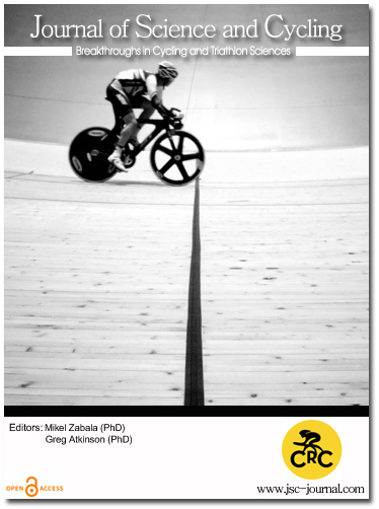Evaluation of comfort: Acceleration transmissibility of different road bikes
Abstract
Background: Cycling training volume is very important for professional cyclists. According to Pinot and Grappe (2014), a top-10 cycling Grand Tour finisher rides ~30,000 km and 950 h during one complete season. In this condition several factors can induce muscular injuries or fatigue such as training load, number of competitions, quality of the recovery, and posture adopted on bike. One possible additional factor for increasing this risk is related to the vibration exposure encountered during cycling on cobblestones. According to the norms and guidelines used in the world of work (e.g. EN-ISO-5349-1, 2001), this vibratory exposure could theoretically only be tolerable for seven minutes (Chiementin and al., 2011; 2013), which is very low compared to the total time spent on cobblestones during a classic cycle race like Paris-Roubaix (~1.5 h). It has been shown also that settings (tyre pressure) and bike components (frame, wheels and fork) play a key role in the transmissibility of the mechanical vibrations to the cyclists’ hands and buttock (Lepine et al., 2014). Thus to reduce the vibratory dose suffered by the cyclists, it seems interesting to choose the most appropriate settings and bike components in order to prevent muscular injuries or fatigue and, potentially, to increase cycling performance.
Purpose: The aim of this study was to assess acceleration transmissibility from the tyres to the handlebar and the seatpost on different road bikes designed or not with damping systems against vibration exposure encountered on cobblestones.
Methods: Five different carbon bikes (Table 1) have been tested on a vertical vibration plate (Physioplate Fit, Globus, Domino Srl, Codognè, Italia). The vibration (from 15.8 to 56.7 Hz) was applied successively under the front and the rear wheel. All the tests were performed by the same cyclist in the same body position and with wheels inflated to 7 bars. Three triaxle accelerometers (1350 Hz, Hikob Fox, Hikob, Villeurbanne, France) were firmly mounted on the vibration plate, the stem and the seat post (Figure 1). Transmissibility has been computed from the ratio between the root mean square (RMS) measured on the stem (output) to the RMS measured on the vibration plate (input).
Results and Discussion: Figure 2 shows that the sensitivity of the protocol proposed in the present study was able to determine differences between bikes, even if the bikes were built in the same material (carbon) or made by the same manufacturer (Table 1). Therefore, it would be used by manufacturers to optimize the comfort and the performance of their bikes, and also by cyclists to choose the “best” bike configuration to minimize the vibration exposure. Nevertheless, this choice should be confirmed by tests in actual conditions in order to evaluate the comfort and the sensation the cyclist experiences according to the racing configuration. Moreover it is quite surprising that bikes designed with damping systems (bike 1 to 3) did not always present the lowest transmissibility values, especially for low frequency vibrations (< 32 Hz). Further studies should be conducted in order to explain these differences.
Downloads
Published
How to Cite
Issue
Section
Copyright (c) 2015 Journal of Science and Cycling

This work is licensed under a Creative Commons Attribution-NonCommercial 4.0 International License.
Authors contributing to Journal of Science and Cycling agree to publish their articles under a Creative Commons CC BY-NC-ND license, allowing third parties to copy and redistribute the material in any medium or format, and to remix, transform, and build upon the material, for any purpose, even commercially, under the condition that appropriate credit is given, that a link to the license is provided, and that you indicate if changes were made. You may do so in any reasonable manner, but not in any way that suggests the licensor endorses you or your use.
Authors retain copyright of their work, with first publication rights granted to Cycling Research Center.






